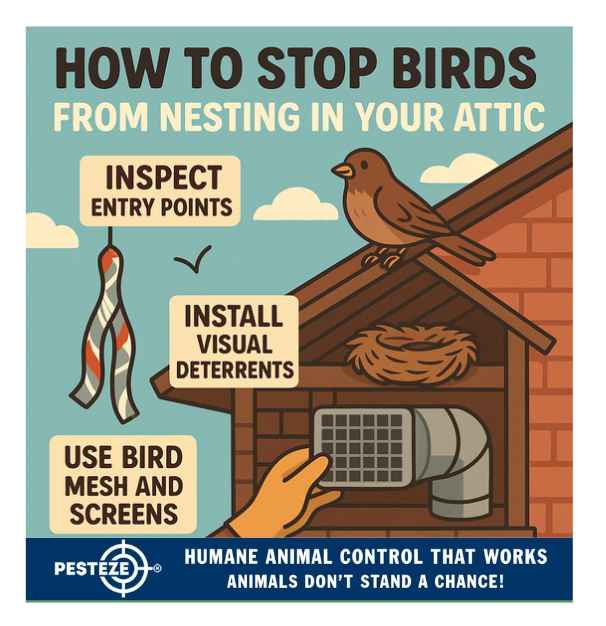HOW TO STOP BIRDS FROM NESTING IN YOUR ATTIC

HOW TO STOP BIRDS FROM NESTING IN YOUR ATTIC
SUMMARY
This guide explains safe, humane methods to prevent birds from nesting in your attic. Learn how to identify access points, use deterrents, and maintain your home to protect against property damage and health risks caused by nesting birds.
FEATURES
-
Inspect Entry Points: Find gaps, vents, and openings where birds enter.
-
Use Bird Mesh and Screens: Cover vents and openings securely.
-
Install Visual Deterrents: Use reflective tape or fake predators to discourage nesting.
-
Maintain Cleanliness: Remove nesting materials and debris.
-
Ensure Proper Vent Covers: Check and replace damaged soffits or eave screens.
-
Use Humane Removal Techniques: If birds are present, contact wildlife professionals.
GUIDE DESCRIPTION
Birds may seem harmless, but when they nest inside your attic, they can cause significant issues. Their droppings can damage insulation, spread disease, and create unpleasant odors, while their nesting materials pose a fire risk. To protect your home and the birds themselves, it’s important to use humane and preventive methods to keep them from nesting indoors.
Start with a careful inspection of your attic and roof exterior. Look for openings around vents, eaves, chimneys, and rooflines. Birds often squeeze through small gaps or damaged screens to build nests in warm, sheltered spaces. You may also notice feathers, chirping sounds, or droppings near entry points. Once identified, make sure there are no active nests before sealing the gaps — many bird species are legally protected, so removal must be handled carefully and ethically.
After confirming your attic is bird-free, close off all potential access points. Use durable materials like hardware cloth, bird netting, or galvanized mesh to cover vents and gaps. Check that soffits and fascia boards are intact and repair any loose shingles or broken seals. For chimneys, install a fitted cap or mesh cover that allows smoke to escape while blocking wildlife entry.
In addition to physical barriers, consider installing visual or auditory deterrents. Reflective tape, shiny pinwheels, or owl decoys can make birds uneasy about approaching your roof. Some homeowners also use ultrasonic bird repellers that emit sounds birds dislike but are inaudible to humans. Rotate these deterrents periodically so birds don’t become accustomed to them.
Maintaining cleanliness is another key step. Remove any old nesting materials or droppings using gloves and disinfectant to prevent the spread of parasites or bacteria. Avoid leaving open food containers or pet dishes outside, as these can attract birds looking for easy meals. Keep your gutters and roofline clear of debris, as this discourages nesting and helps with water drainage.
Finally, perform regular seasonal checks to ensure your home stays secure. Birds are persistent, and even small openings can invite them back. By combining exclusion techniques, deterrents, and regular upkeep, you can ensure that your attic remains a safe, quiet, and bird-free space — all while protecting wildlife in a humane way.
- Saneeth Thota


Comments 0